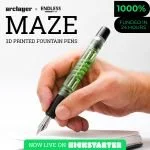(Susan M. Pigott is a fountain pen collector, pen and paperholic, photographer, and professor. You can find more from Susan on her blog Scribalishess.)
The Pilot Custom Heritage 912 is not a particularly remarkable pen on the outside. It is black resin with rhodium-plated rings at the juncture of the grip and barrel, at the bottom of the barrel, and at the top and bottom of the cap. The clip is unadorned, and the only branding is on the cap ring which says "Custom Heritage 912 Pilot Japan."
The 912 comes with a CON-70 push-button converter that holds a good amount of ink (0.6 ml). I much prefer this to Pilot's other converters, but I will say this one is tough to clean thoroughly. You have to flush it repeatedly, and the ink tends to get caught in the nooks and crannies of the converter.
It is a light pen, weighing in at only 25 grams. The length is comfortable posted (6.18 inches) or unposted (just under 5 inches).
What makes the 912 shine is the 14K rhodium-plated FA nib (you can, of course get the pen with other nibs). The FA nib (short for Falcon) has cutouts that look like wings.
This design allows the nib to flex when the writer applies pressure to it.
Unlike a Soft Fine nib, which is simply less firm and offers no flex, the tines of an FA nib actually spread, giving that coveted line variation so many writers love.
You can also write normally with the FA nib, and it has a lovely spring to it.
My 912 worked perfectly out of the box. I inked it with Pilot Iroshizuku Yama-budo, and I spread the tines as far as I dared. The ink flowed perfectly and the nib floated on the paper. However, when my bottle of Montblanc Blue Hour arrived, I tried it with the 912. Boy, was I disappointed. The nib railroaded almost immediately. I tried priming the nib, forcing more ink down, but nothing worked.
Wondering if this was a problem with the ink or the nib, I experimented with several different inks. You can see the railroading with Blue Hour, but none of the other inks caused any problems.
I read on some other blogs that the FA nib works best with Pilot inks, but I tried several different brands and they all worked fine. In fact, I tried Blue Hour again after all my tests and suddenly it worked perfectly. I can't explain this. Maybe by the time I tried Blue Hour again, the nib and feed had been flushed so many times they were able to handle a drier ink.
Still, Yama-budo is my go-to ink for this pen. It is such a happy color (it forces me out of my blue ink rut), and the FA nib almost makes my writing look Spencerian . . . almost.
Aside from the initial railroading problem, the only other negative is nib creep. I noticed this from day one. For whatever reason, ink creeps between the tines and pools on the nib's surface. From what I've read, this is caused either by the wetness of the ink or possible hairline fissures in the nib. It doesn't affect the writing, but I get a little OCD-irritated that the nib surface isn't pristine. If I try to wipe it clean, more ink just smears over it. It's a Sisyphian battle. I lost.
No modern pen has yet managed to duplicate the super-flex pens of old. But, if you want the convenience of a modern filling system (no dried up sacs, no broken lever boxes, no rotten cork seals) and a smooth, flexy nib, the 912 FA is a great choice. I honestly did not expect to like this pen as much as I do. I planned to review it and then sell it. But that's not going to happen. This is a keeper.
I purchased my Pilot Custom Heritage 912 with the FA nib through Amazon for $155.37. The seller was in Japan, so it took almost a month for the pen to arrive. That seller does not currently offer this pen anymore, but you can check Amazon periodically to see if it becomes available. Classic Fountain Pens has the pen back in stock ($256), so you can order from them or from your favorite Japanese eBay dealer.
Pros
- Lightweight pen for comfortable writing
- Good ink supply with the CON-70 converter
- The FA nib is a wonderful option for people who desire flex but don't want to use vintage pens
- Simple, elegant design
Cons
- The pen only comes in black; I wish they offered a variety of colors
- The CON-70 converter is difficult to clean completely
- The pen can be difficult to obtain in America
- Fairly expensive for a plastic pen (though the nib is 14K)



















